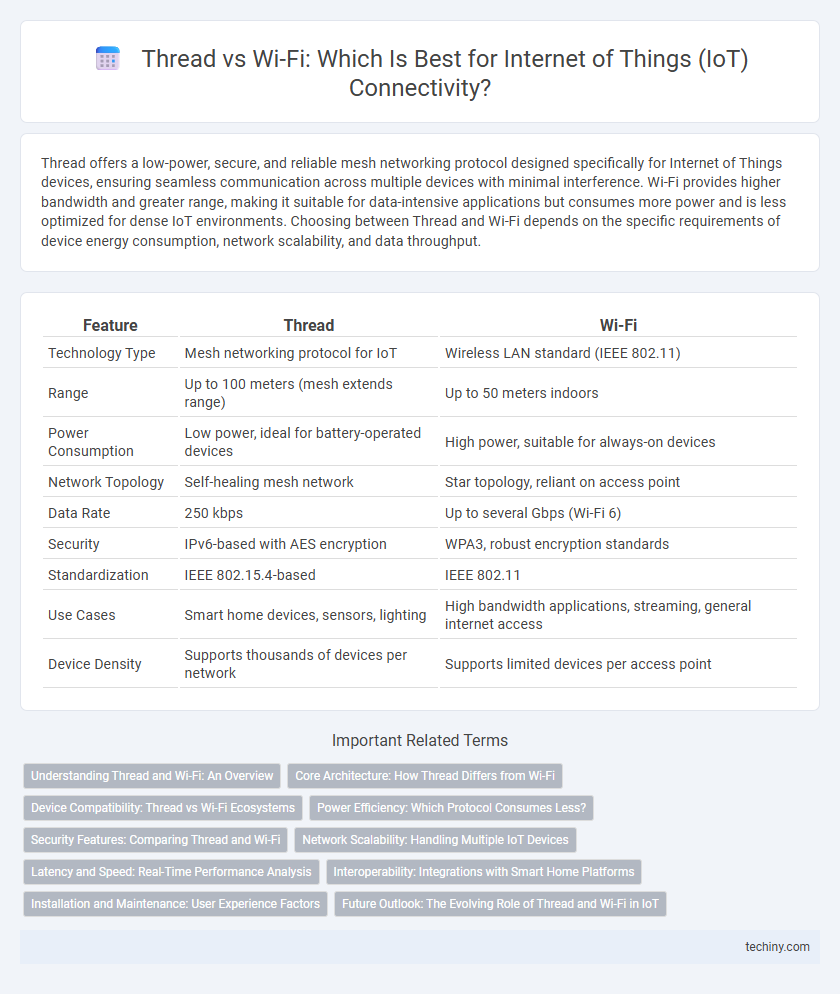Thread offers a low-power, secure, and reliable mesh networking protocol designed specifically for Internet of Things devices, ensuring seamless communication across multiple devices with minimal interference. Wi-Fi provides higher bandwidth and greater range, making it suitable for data-intensive applications but consumes more power and is less optimized for dense IoT environments. Choosing between Thread and Wi-Fi depends on the specific requirements of device energy consumption, network scalability, and data throughput.
Table of Comparison
| Feature | Thread | Wi-Fi |
|---|---|---|
| Technology Type | Mesh networking protocol for IoT | Wireless LAN standard (IEEE 802.11) |
| Range | Up to 100 meters (mesh extends range) | Up to 50 meters indoors |
| Power Consumption | Low power, ideal for battery-operated devices | High power, suitable for always-on devices |
| Network Topology | Self-healing mesh network | Star topology, reliant on access point |
| Data Rate | 250 kbps | Up to several Gbps (Wi-Fi 6) |
| Security | IPv6-based with AES encryption | WPA3, robust encryption standards |
| Standardization | IEEE 802.15.4-based | IEEE 802.11 |
| Use Cases | Smart home devices, sensors, lighting | High bandwidth applications, streaming, general internet access |
| Device Density | Supports thousands of devices per network | Supports limited devices per access point |
Understanding Thread and Wi-Fi: An Overview
Thread operates as a low-power, secure mesh networking protocol designed specifically for connecting Internet of Things (IoT) devices within home automation systems, enabling reliable communication even in complex environments. Wi-Fi provides high-speed, wide-range internet access, supporting larger data transfers and device connectivity but often with higher power consumption in IoT applications. Understanding these differences helps optimize device performance by selecting Thread for energy-efficient, scalable device interconnectivity and Wi-Fi for bandwidth-intensive tasks requiring stable internet access.
Core Architecture: How Thread Differs from Wi-Fi
Thread uses a low-power, IPv6-based mesh networking protocol designed for reliable, secure communication between IoT devices, contrasting with Wi-Fi's traditional star topology that relies on access points. Thread's core architecture emphasizes decentralized device-to-device connectivity, enabling self-healing and scalable networks, while Wi-Fi depends heavily on centralized routers and higher power consumption. The focus on lightweight, low-latency networking in Thread enables seamless integration and extended battery life for smart home applications compared to Wi-Fi.
Device Compatibility: Thread vs Wi-Fi Ecosystems
Thread supports seamless device compatibility within low-power, mesh-network environments, enabling hundreds of connected devices to communicate efficiently in smart homes and IoT ecosystems. Wi-Fi offers broad compatibility across a vast range of devices and existing infrastructure, prioritizing high data throughput but consuming more power and bandwidth. Thread's IP-based networking ensures scalability and interoperability among IoT devices, while Wi-Fi remains the preferred choice for high-bandwidth applications needing direct internet access.
Power Efficiency: Which Protocol Consumes Less?
Thread protocol consumes significantly less power than Wi-Fi, making it ideal for battery-operated Internet of Things devices. Thread utilizes low-power mesh networking with optimized communication intervals, reducing energy consumption compared to Wi-Fi's continuous, high-bandwidth transmissions. Consequently, IoT deployments requiring extended device lifespan favor Thread for its superior power efficiency.
Security Features: Comparing Thread and Wi-Fi
Thread employs robust AES-128 encryption with mandatory device authentication and secure key exchange protocols, enhancing network integrity in IoT applications. Wi-Fi security varies by standard, with WPA3 offering advanced protection but earlier versions like WPA2 being more vulnerable to attacks. Thread's mesh networking inherently reduces single points of failure, contributing to greater resilience compared to traditional Wi-Fi infrastructure.
Network Scalability: Handling Multiple IoT Devices
Thread supports extensive network scalability through its mesh architecture, enabling hundreds of IoT devices to communicate efficiently with low power consumption. Wi-Fi, while widely compatible, faces challenges in managing large numbers of devices due to higher power demands and limited simultaneous connections on typical routers. As a result, Thread offers superior scalability for expansive IoT deployments requiring reliable, low-latency communication.
Latency and Speed: Real-Time Performance Analysis
Thread protocol offers lower latency than Wi-Fi, typically achieving sub-15 ms response times ideal for real-time IoT applications. Wi-Fi provides higher speed bandwidth up to 1 Gbps but often incurs latency above 50 ms, which can hinder time-sensitive device interactions. Evaluating Thread's mesh network efficiency against Wi-Fi's broader coverage reveals trade-offs between ultra-responsive communication and high data throughput in IoT environments.
Interoperability: Integrations with Smart Home Platforms
Thread offers superior interoperability with smart home platforms by providing a low-power, mesh networking protocol specifically designed for reliable device-to-device communication. Unlike Wi-Fi, Thread seamlessly integrates with ecosystems like Apple HomeKit, Google Nest, and Amazon Alexa, enabling consistent and secure connectivity across diverse IoT devices. This native compatibility reduces latency and enhances user experience by simplifying the setup and management of smart home networks.
Installation and Maintenance: User Experience Factors
Thread offers simplified installation with automatic network configuration, reducing user setup time and minimizing technical barriers compared to Wi-Fi. Wi-Fi requires manual configuration and frequent maintenance due to interference and firmware updates, often leading to inconsistent user experiences. Thread's self-healing mesh network enhances reliability and lowers ongoing maintenance demands, improving overall user satisfaction in IoT environments.
Future Outlook: The Evolving Role of Thread and Wi-Fi in IoT
Thread is emerging as a low-power, secure, and scalable mesh networking protocol ideal for smart home and industrial IoT applications, enabling seamless device interoperability. Wi-Fi continues to dominate with high bandwidth and widespread infrastructure, supporting data-intensive tasks and real-time communication in IoT ecosystems. The future of IoT connectivity lies in hybrid solutions that leverage Thread's energy efficiency and mesh capabilities alongside Wi-Fi's range and speed for optimized network performance.
Thread vs Wi-Fi Infographic

 techiny.com
techiny.com